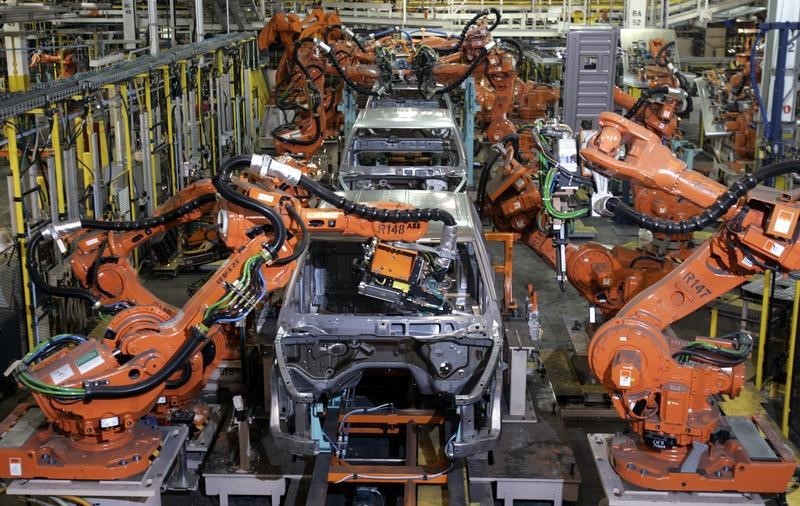By Lucia Mutikani
WASHINGTON (Reuters) - U.S. private employers hired the most workers in six months in June and factory activity picked up, providing fresh evidence the economy was gathering solid momentum after contracting at the start of the year.
The brightening growth outlook was also bolstered by other data on Wednesday showing auto sales remained strong in June and construction spending rose in May to its highest level in just over 6-1/2 years.
The recent raft of upbeat data supports views of a September interest rate hike from the Federal Reserve, although market-based forecasting tools suggest lift-off may not occur until late in the year or even in 2016.
"The economy has shifted back into solid growth mode. A strong June jobs number would make it clear the economy can absorb a rate hike and the Fed can move at any time it wants," said Joel Naroff, chief economist at Naroff Economic Advisors in Holland, Pennsylvania.
The ADP National Employment Report showed 237,000 private-sector jobs were created in June, beating the median expectation among economists surveyed by Reuters for a gain of 218,000 jobs. Private payrolls increased 203,000 in May.
June's gain marked the third straight month of improvement since the pace of hiring had slumped to a 14-month low back in March. Job increases last month were led by small businesses and the services sector.
Employment in the construction industry increased 19,000 jobs, though down from the 28,000 jobs added in May. Manufacturing payrolls rose 7,000, more than recouping the 2,000 jobs lost in May.
U.S. stocks ended higher on the economic data, but gains were curbed as Greece's debt crisis showed no clear sign of resolution. The dollar firmed against a basket of currencies, while prices for U.S. Treasury debt fell.
The ADP report, which is jointly developed with Moody's Analytics, came ahead of the government's more comprehensive employment report on Thursday.
According to a Reuters survey of economists, nonfarm payrolls likely increased 230,000 in June after a robust 280,000 gain in May. The jobless rate was forecast dipping one-tenth of a percentage point back to a seven-year low of 5.4 percent.
FACTORIES HUMMING
"The U.S. job machine remains in high gear. The current robust pace of job growth is double that needed to absorb the growth in the working-age population," said Mark Zandi, chief economist for Moody's Analytics in West Chester, Pennsylvania.
In a separate report, the Institute for Supply Management said its national factory activity index rose to 53.5 in June, a five-month high, from a reading of 52.8 in May. It was the second straight month of gains in the index.
A reading above 50 indicates expansion in the manufacturing sector. A gauge of new orders received by factories increased for a third straight month.
Eleven out of 18 industries, including furniture, fabricated metal products, computer and electronic products, and electrical equipment, appliances and components reported growth in June. Four industries, including petroleum and coal products, and primary metals, reported activity contracted.
Last month's pickup in factory activity is a welcome development for the sector, which is struggling with the lingering effects of dollar strength and lower energy prices.
Factory activity could get a boost from robust automobile sales. Data on Wednesday showed strong demand for sport utility vehicles and trucks in June helped General Motors Co (N:GM) and Ford Motor Co (N:F) offset slowing demand for sedans by allowing them to raise prices on their trucks.
Overall auto sales slowed to a still-hefty seasonally adjusted annual rate of 17.16 million units in June from May's best-in-a-decade pace of 17.80 million units, according to Autodata Corp. June sales marked the third month in the last four to run above the 17 million units mark.
Economic reports, including employment, consumer spending, confidence and housing, have assumed a strong note in recent months, suggesting growth was gaining steam after gross domestic product fell at a 0.2 percent annual rate at the start of 2015.
The economy was hit by bad weather, port disruptions, a strong dollar and spending cuts in the energy sector in the first quarter.
In a third report, the Commerce Department said construction spending increased 0.8 percent to an annual rate of $1.04 trillion in May, the highest level since October 2008.
Gains were broad-based, but more pronounced in the private nonresidential segment. Economists said that should offset the drag on second-quarter growth from weak oil and gas drilling.
"Construction spending looks set to add significantly to second-quarter GDP growth," said John Ryding, chief economist at RDQ Economics in New York.
